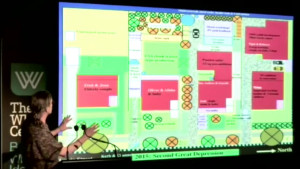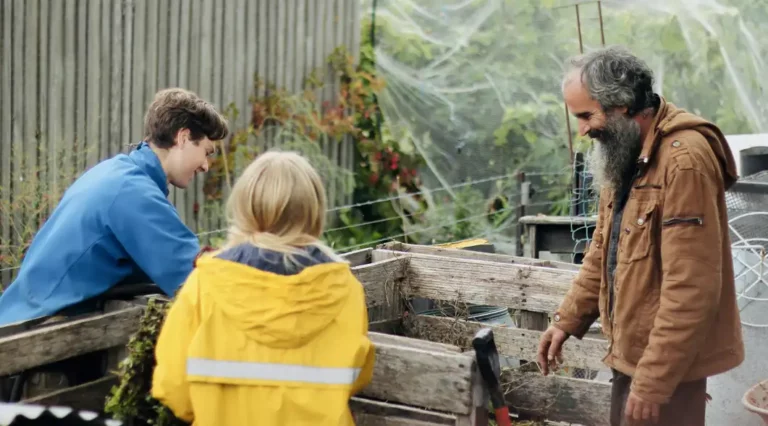
David presents Aussie Street at the Wheeler Centre
In 2002 I explored permaculture as thinking tools for the energy descent future in Permaculture: Principles and Pathways Beyond Sustainability.
In 2008 I outlined a more nuanced and over-the-horizon view of the diverse ways in which that energy descent future might unfold in Future Scenarios (first published on line).
Since then “resilience” has displaced “sustainability” as the buzzword about the future, while “energy descent” is still lurking in the conceptual fringes.
But over those years I have also been working on another book that focuses on the residential landscapes, backyards and behaviours of suburbia where most Australians live or were raised. A lot less theoretical and dense than Principles, and less threatening than Future Scenarios, RetroSuburbia builds on my Aussie St presentations showing how ordinary Australians can downshift and retrofit their houses, gardens and lifestyles to be much more sustainable and resilient (to survive and thrive energy descent futures).
The lucky country is likely to get a big shake up from the bursting of the property bubble, the ongoing collapse of prices for Australian exports, more extreme weather events and geopolitical crises.
Older homeowners without debt are worried about the future of their children and grandchildren. The incremental and ongoing retrofit of the built, biological and behavioural domains of the household is recognised by many as the best bet to weather the storms of uncertain times and contribute to a better future for the next generations.
While concern about the future is a strong motivation for some downshifters, others are driven by the desire to get a better life now, respond to a health crisis or protect their children from media saturated lifestyles and toxic values. For many young (and middle aged) couples contemplating “settling down” and a family, the problem of how to get a home without massive mortgage debt, where they can be themselves, is a problem that needs more creative solutions.
For many environmental activists struggling to find fulfilment in the battles to “stop the world we don’t want”, growing their own food and repurposing what others throw away, provides an oasis from which they can renew their energies and spirit for the “work” of trying to project those positive changes into their communities and the wider world. Whatever the motivations, a psycho-social space has emerged where the pioneers on this path can provide models for those searching for a better way of living.
The retro style of hipsters maybe mostly manufactured by marketers, but there is a link between this style and the revival of enthusiasm for DIY tech, food growing and self-reliant living. Conservative suburbia of the 1950s and 60s included a level of self-reliance and backyard productivity that would today be considered cool. The freedom of children to create their own world would today be thought edgy and radical. The 1970s, which is the focus of so much retro fashion, was when permaculture strategies and activism first promised a grass roots transformation of suburbia, while ignoring the fashions of the day. This was the time of the oil crises when the term “retrofitting” was popularised (especially in America) to describe making houses more fit for purpose in an energy frugal future. In Melbourne, the retrofit of a typical Brunswick weatherboard house into the CERES Low Energy Display House, included a permaculture designed food garden. Over the decades since, this and other iconic precedents for the current wave of retrofitting and downshifting, became sanitised and corralled by a resurgence of bureaucracy and corporate mentality. But the spirit and energy to “just do stuff” and “create the world we want” that has always been the driving passion behind permaculture, is having a resurgence in the status of home grown, freshly foraged, home brewed and hand crafted.
Due for publication in May 2017, my latest book builds on writings and presentations about “Retrofitting the Suburbs for the Energy Descent Future” that since 2005 have highlighted the ongoing and incremental changes to our residential landscapes to make them “fit for purpose” before Australia and the world slide into energy descent futures. My Aussie St story tracing four adjacent suburban houses and their inhabitants from the “1950s Golden Age of Suburbia” to the “Second Great Depression of 2020” has been particularly powerful at engaging with Australians who live in or grew up in suburbia.
RetroSuburbia explains and illustrates patterns, designs and behavioural strategies applied by those already on the downshifting path to a resilient future, using permaculture ethics and principles. It is organised as a pattern language of interlocking and complementary design solutions to perennial problems faced by those applying a more systematic, whole-of-household approach to retrofitting their houses, gardens and living arrangements. It includes some proven design specifications and pointers, references technical sources and case studies, but is more of a strategic guide than a technical manual.
Rather than reviewing the latest technology for thermally efficient heating, the book has an overview of wood energy options that increase resilience and productivity of the household, some of which can be manufactured in a home workshop. Rather than details on how to grow vegetables or raise chooks, it describes the different systems for doing so, and their pros and cons in various situations. A lot of the technical detail is conveyed with graphics. This book will help you get your hands dirty tackling tricky issues with creative solutions, including those that might be seen as socially or even legally questionable. Harness the tradition of Aussie DIY to reclaim common sense self reliance while ignoring the overregulation, risk management myopic and dependence on centralised authority that afflicts affluent Australia. In the process, help create a broader, more holistic culture of DIO (doing it ourselves) which rebuilds the non-monetary economies of the household and community.
Whether retrofitting is focused on a long established, extended family home, a move to cheaper property near like minded others, going part time, working from home, or growing most of your fresh food, there are many ways to reduce dependence on money and debt, create “a new normal” for children and rebuild the community economy. All this can be done without the need to ask the permission of the usual gatekeepers in the banks, government and the media.
Behaviour change is the “low hanging fruit” by which we could gracefully adapt to, and even thrive in energy descent futures. In the right conditions, behaviour can be shifted more rapidly than remodelling the house or growing a garden that are both subject to the laws of physics and the cycle of the seasons.
On the other hand, entrenched dysfunctional habits can undermine good design and action in the built and biological domains, lead to family and community break ups and resignation that a more self reliant and low footprint way of life is too difficult. For these reasons, a substantial part of the book focuses on the patterns of adaptive behaviour at the personal and household levels that can be the springboard for adaptive community level change.
The suburban retrofit concepts have national and global application, but the book is focused on Melbourne, Victorian regional towns and more generally southern Australia for several reasons;
- On this home territory, it concentrates on the strategies, techniques and designs that work without the need to cover all the variations that are appropriate in other climates and contexts.
- If we can help trigger an order of magnitude jump in the number of household retrofitting projects in Melbourne and regional Victoria, that could generate responses from academics, policy makers and activists in the context of the Melbourne metropolitan councils participation in the global Rockefeller Foundation funded 100 Resilient Cities Challenge.
- If we succeed on that scale, then the RetroSuburbs movement here, will help inspire similar action around Australia and beyond. Permaculture designers and Transition town activists everywhere will readily adapt the solutions beyond this bioregion.
I think RetroSuburbia captures the ambiguity of a radical transformation for the future and the easy recreation of the best from the past. If this project aligns with your personal, household, enterprise or community level aims and actions, sign up to our newsletter to keep updated and get involved.
David Holmgren
co-originator of the permaculture concept
